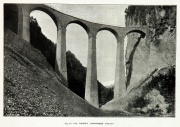Difference between revisions of "Landwasser Viaduct"
| Line 1: | Line 1: | ||
[[Image:Im1904EnV97-p363a.jpg|thumb| 1904. ]] | [[Image:Im1904EnV97-p363a.jpg|thumb| 1904. ]] | ||
[[Image:Im1904EnV97-p363b.jpg|thumb| 1904. During construction.]] | [[Image:Im1904EnV97-p363b.jpg|thumb| 1904. During construction.]] | ||
The Landwasser Viaduct is a single track six-arched curved limestone railway viaduct. It spans the Landwasser River between Schmitten and Filisur, in the Canton of Graubünden, Switzerland. | |||
Designed by Alexander Acatos, it was built between 1901 and 1902 by Müller and Zeerleder for the Rhaetian Railway, which still owns and uses it today. A signature structure of the World Heritage-listed Albula Railway, it is 65 metres (213 ft) high, 136 metres (446 ft) long, and one of its ramps exits straight into the Landwasser Tunnel. | |||
== See Also == | == See Also == | ||
| Line 7: | Line 11: | ||
== Sources of Information == | == Sources of Information == | ||
<references/> | <references/> | ||
* [http://en.wikipedia.org/wiki/Landwasser_Viaduct Wikipedia] | |||
{{DEFAULTSORT: }} | {{DEFAULTSORT: }} | ||
[[Category: | [[Category: Country - Switzerland]] | ||
[[Category: Bridges and Viaducts]] | [[Category: Bridges and Viaducts]] | ||
Revision as of 09:43, 29 May 2014
The Landwasser Viaduct is a single track six-arched curved limestone railway viaduct. It spans the Landwasser River between Schmitten and Filisur, in the Canton of Graubünden, Switzerland.
Designed by Alexander Acatos, it was built between 1901 and 1902 by Müller and Zeerleder for the Rhaetian Railway, which still owns and uses it today. A signature structure of the World Heritage-listed Albula Railway, it is 65 metres (213 ft) high, 136 metres (446 ft) long, and one of its ramps exits straight into the Landwasser Tunnel.



